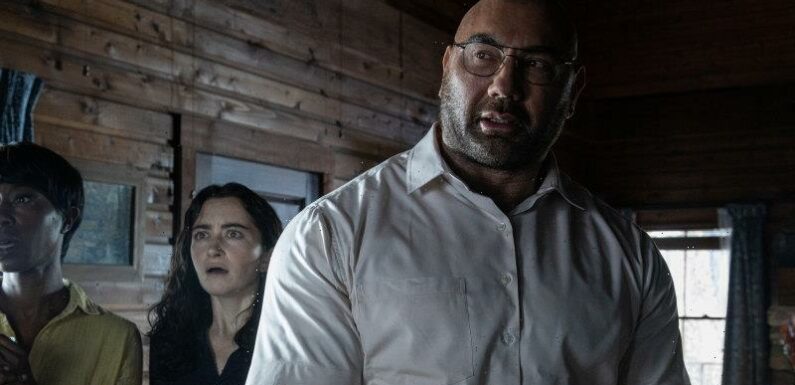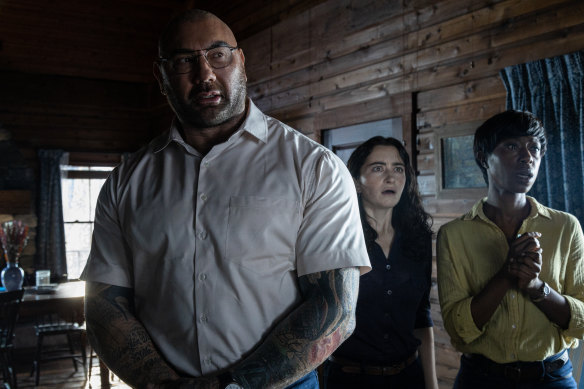
KNOCK AT THE CABIN
Directed by M. Night Shyamalan
Written by Shyamalan, Steve Desmond and Michael Sherman
100 minutes, rated M
General release
★★★
Tales of impending apocalypse seem unlikely to go out of style in the near future any more than actual war, disease and famine look like fading away. All of which is good news for M. Night Shyamalan, for many years now a leading exponent of the paranoid style in American cinema.
He’s at it again in his horror-thriller Knock at the Cabin, adapted from Paul G. Tremblay’s 2018 novel The Cabin at the End of the World. Like other latter-day Shyamalan projects, it’s a claustrophobic nightmare built around a small cast and one main location, boosting the sense of entrapment while cutting down the budget.
Dave Bautista, Abby Quinn, and Nikki Amuka-Bird in Knock At The Cabin.
When we first meet eight-year-old Wen (Kristen Cui), she’s wandering the woods in search of grasshoppers to keep in a jar. Before long, she’ll be a prisoner herself trussed up alongside her dads Eric (Jonathan Groff) and Andrew (Ben Aldridge) by a group of weirdos who have broken into the cabin where the family is staying.
Leading this home invasion is the hulking but soft-spoken Leonard (Dave Bautista), who claims to be a primary school teacher in his other life. Like the others in his sect (played by Nikki Amuka-Bird, Abby Quinn and Rupert Grint) he’s been experiencing awful visions of the future: catastrophe can be averted, they believe, but at a cost.
What follows is the usual Shyamalan mix of wackiness and violence, unevenly scripted but inventively shot: mega-close-ups and disorientating focal shifts give cosmic weight to the small-scale drama, while a big-screen TV in a corner of the cabin serves as a window onto the wider world.
Much of this is anchored in the point of view of little Wen, who has even less grasp of the big picture than we do. When violence looms she often literally turns her face away, and Shyamalan accordingly leaves much of the horror to the imagination – which is a smart choice, especially compared to the scenes that rely on ropey digital effects.
Yet the film is also a vehicle for Bautista, easily the biggest star in the cast – who has a childlike quality of his own, and plays Leonard as a simple-minded, even endearing fellow rather than a straightforward villain. True, some basic questions about the character are never answered, but we can assume he’s acting from sincere motives, whatever these might be.
That in turn carries some disconcerting implications. Shyamalan’s sense of humour is so strange it’s often unclear when he’s pulling the viewer’s leg, but in this case the emphasis on the threat of global catastrophe feels like more than a genre convention (the script was finished in 2021 and shot mid-2022, which is to say that the film, unlike Tremblay’s novel, is very much post-pandemic).
Nor is it hard to find real-world parallels for the dogmas espoused by Leonard and his associates, who are convinced humanity is being judged for its sins, even if they’re never very clear about who’s meant to be doing the judging.
So where does Shyamalan himself stand in all this? While his movies often turn on battles between faith and scepticism, as a rule we’re allowed no certainty about which side will triumph: the door is always open for one of his famous twist endings, where everything we thought was true turns out to be a lie or vice versa.
While the uncertainty persists in Knock at the Cabin, the stakes of the game are somewhat different. Perhaps there’s a limit to how much ambiguity feels appropriate, in a movie about a gay couple and their adopted child being terrorised by religious fanatics – which is literally and centrally what happens here, however often Leonard and his associates insist their presence has nothing to do with Eric and Andrew’s relationship.
While Shyamalan can’t be said to lack nerve as a filmmaker, he’s reshaped Tremblay’s original ending into something much less stark – and however fiercely he insists on the love that unites the members of this non-traditional family, it’s as if he felt that the safest way to tell their story was to ensure homophobes too could watch and feel seen. Or is that just the paranoia talking?
A cultural guide to going out and loving your city. Sign up to our Culture Fix newsletter here.
Most Viewed in Culture
From our partners
Source: Read Full Article
